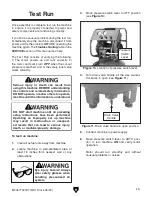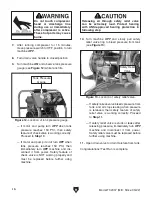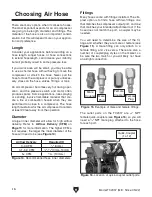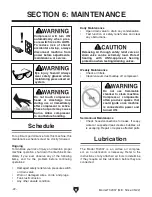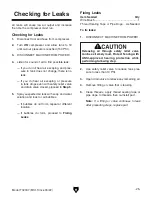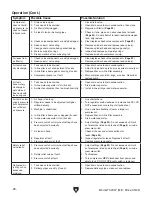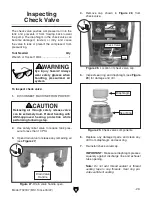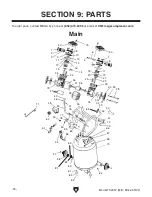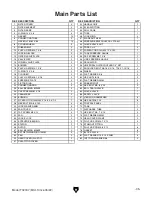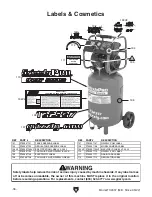
Model T32337 (Mfd. Since 05/22)
-27-
Symptom
Possible Cause
Possible Solution
Machine has
vibration or
noisy operation.
1. Motor or component loose.
2. Wheels or machine feet loose.
3. Motor fan rubbing on fan cover.
4. Motor bearings at fault.
5. Compressor pump at fault.
1. Replace damaged or missing bolts/nuts or tighten if
loose.
2. Tighten fasteners.
3. Fix/replace fan cover; replace loose/damaged fan.
4. Test by rotating shaft; rotational grinding/loose shaft
requires bearing replacement.
5. Compressor piston rod/bearings/crankshaft is worn.
Rebuild or replace pump.
Motor runs
continuously.
1. Machine is undersized.
2. Regulator needs to be adjusted for lower
airflow delivery.
3. Air leak in tank or delivery pipes.
4. Pressure switch at fault.
1. Use a smaller attachment tool or a larger air
compressor.
2. Turn regulator knob counterclockwise to decrease line
PSI.
3. Check air tank, pipes, and all connections for leaks
(
Page 25). Do not attempt to repair leaking/damaged
tank, only replace.
4. Turn compressor
OFF, disconnect from power, and
empty tank. DO NOT USE until switch is replaced.
Pressure relief
valve stays
open and motor
will not stop
running.
1. Pressure switch cut-in/cut-out settings have
been adjusted incorrectly.
2. Pressure switch at fault, unit is trying to
overpressurize tank.
3. Pressure relief valve at fault/relieving
pressure too early.
1. Adjust settings (
Page 30). Do not exceed cut-in/cut-
out pressures listed on data sheet (
Page 6) or inside
pressure switch.
2. Turn compressor
OFF, disconnect from power, and
empty tank. DO NOT USE until switch is replaced.
3. Replace.
Motor & Electrical (Cont.)
Operation
Symptom
Possible Cause
Possible Solution
Air leaks from
pressure
switch.
1. Check valve components are dirty/damaged.
2. Pressure switch at fault.
1. Clean/replace check valve components (
Page 29).
2. Turn compressor
OFF, disconnect from power, and
empty tank. DO NOT USE until switch is replaced.
Low pressure
in tank, or
tank pressure
drops after
compressor is
turned
OFF.
1. Drain valve is open.
2. Air filter(s) dirty/clogged.
3. Regulator needs to be adjusted for lower
airflow delivery.
4. Pressure switch cut-in/cut-out settings have
been adjusted incorrectly.
5. Air leak in tank or delivery pipes.
6. Check valve components are dirty/damaged.
7. Pressure relief valve releasing below 150
PSI.
8. Gasket(s) leaking.
9. Worn pump piston rings.
1. Close drain valve.
2. Replace air filter(s) (
Page 23).
3. Turn regulator knob counterclockwise to decrease line
PSI.
4. Adjust settings (
Page 30). Do not exceed cut-in/cut-
out pressures listed on data sheet (
Page 6) or inside
pressure switch.
5. Check air tank, pipes, and all connections for leaks
(
Page 25). Do not attempt to repair leaking/damaged
tank, only replace.
6. Clean/replace check valve components (
Page 29).
7. Replace pressure relief valve.
8. Check gaskets on cylinder head assemblies, repair or
replace as needed.
9. Inspect and replace pump piston rings.
Compressor
knocking.
1. Air filter(s) dirty/clogged.
2. Piston assembly loose.
1. Replace air filter(s) (
Page 23).
2. Inspect and repair piston and connecting rod.
Summary of Contents for T32337
Page 40: ......



